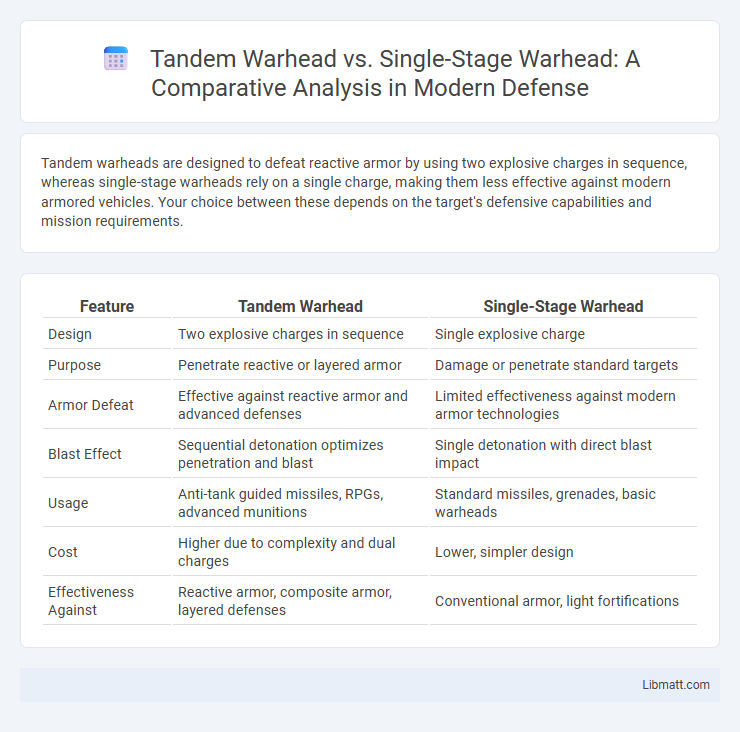Tandem warheads are designed to defeat reactive armor by using two explosive charges in sequence, whereas single-stage warheads rely on a single charge, making them less effective against modern armored vehicles. Your choice between these depends on the target's defensive capabilities and mission requirements.
Table of Comparison
| Feature | Tandem Warhead | Single-Stage Warhead |
|---|---|---|
| Design | Two explosive charges in sequence | Single explosive charge |
| Purpose | Penetrate reactive or layered armor | Damage or penetrate standard targets |
| Armor Defeat | Effective against reactive armor and advanced defenses | Limited effectiveness against modern armor technologies |
| Blast Effect | Sequential detonation optimizes penetration and blast | Single detonation with direct blast impact |
| Usage | Anti-tank guided missiles, RPGs, advanced munitions | Standard missiles, grenades, basic warheads |
| Cost | Higher due to complexity and dual charges | Lower, simpler design |
| Effectiveness Against | Reactive armor, composite armor, layered defenses | Conventional armor, light fortifications |
Introduction to Warhead Types
Tandem warheads feature two explosive charges designed to defeat reactive armor, enhancing effectiveness against armored vehicles. Single-stage warheads rely on a single explosive charge, typically optimized for penetration or blast effect. The choice between tandem and single-stage warheads depends on mission requirements and target protection levels.
Defining Single-Stage Warheads
Single-stage warheads consist of a single explosive charge designed to detonate upon impact or at a predetermined altitude, delivering a direct blast effect against targets. These warheads are simpler in design and typically used for conventional missile systems where a singular explosive event is sufficient. The effectiveness of single-stage warheads depends on factors like explosive yield, delivery velocity, and target hardness, but they lack the enhanced penetration capabilities found in tandem warhead configurations.
Understanding Tandem Warheads
Tandem warheads feature two explosive charges designed to defeat reactive armor, with the first charge detonating the armor and the second penetrating the target. This dual-stage mechanism significantly improves armor penetration effectiveness compared to single-stage warheads, which rely on just one charge. Understanding the functionality of tandem warheads can help you evaluate their superior performance in modern anti-tank and anti-vehicle applications.
Key Differences Between Tandem and Single-Stage Warheads
Tandem warheads feature two explosive charges designed to defeat reactive armor, with the first charge triggering the armor's reaction and the second penetrating the main target, whereas single-stage warheads rely on a single explosive charge that is less effective against advanced armor types. The tandem design enhances penetration capabilities against modern armored vehicles, making it superior in tactical scenarios requiring armor defeat. Your choice between tandem and single-stage warheads should consider the specific threat environment and armor technology you expect to encounter.
Mechanisms of Armor Penetration
Tandem warheads utilize a two-stage mechanism where the first charge neutralizes reactive armor, allowing the second charge to penetrate the base armor more effectively, enhancing overall penetration capabilities. Single-stage warheads rely on a single shaped charge to breach armor, which can be less effective against modern composite or reactive defenses. Your choice between tandem and single-stage warheads should consider the type of armor and the tactical scenario to maximize penetration success.
Countermeasures: Reactive Armor vs. Warhead Designs
Tandem warheads are specifically engineered to defeat reactive armor by employing two shaped charges: the first detonates the reactive armor, while the second penetrates the underlying main armor. Single-stage warheads lack this sequential mechanism, making them less effective against modern reactive armor countermeasures. Your choice of warhead type significantly impacts effectiveness against vehicles equipped with reactive armor systems.
Effectiveness in Modern Battlefields
Tandem warheads offer superior effectiveness on modern battlefields by penetrating advanced reactive and composite armor that single-stage warheads often fail to breach. This dual-charge design allows the initial charge to neutralize explosive reactive armor, enabling the main charge to create a deeper penetration. Consequently, tandem warheads enhance anti-tank capabilities and improve survivability against heavily fortified targets.
Technological Advancements in Warhead Engineering
Tandem warheads represent a significant technological advancement in warhead engineering by incorporating two sequential explosive charges designed to defeat reactive armor, which single-stage warheads often fail to penetrate effectively. The precursor charge in tandem warheads initiates the detonation of explosive reactive armor (ERA), while the main charge follows to inflict damage on the underlying target, optimizing armor penetration and lethal effectiveness. Innovations in explosive materials, detonation timing, and shaped charge design have enhanced the efficiency and destructive capability of tandem warheads compared to conventional single-stage warheads.
Applications in Anti-Tank and Anti-Fortification Weapons
Tandem warheads are specifically designed to defeat reactive armor and hardened targets by using two sequential charges, making them highly effective in anti-tank and anti-fortification weapons. Single-stage warheads deliver a single explosion, which can be less effective against modern armored vehicles equipped with explosive reactive armor (ERA). Your choice of tandem warhead ensures improved penetration and target neutralization in both anti-tank and fortified position applications.
Future Trends in Warhead Development
Future trends in warhead development emphasize enhanced penetration and target neutralization through tandem warheads, which utilize a precursor charge to defeat advanced armor and reactive defenses before the main charge detonates. Single-stage warheads remain relevant for simpler targets, but evolving battlefield requirements drive innovation toward multi-stage designs for greater effectiveness against modern armored vehicles and fortified structures. Your strategic advantage increases by adopting tandem warheads that leverage cutting-edge materials and precise detonation sequencing to counter emerging defense technologies.
tandem warhead vs single-stage warhead Infographic

 libmatt.com
libmatt.com